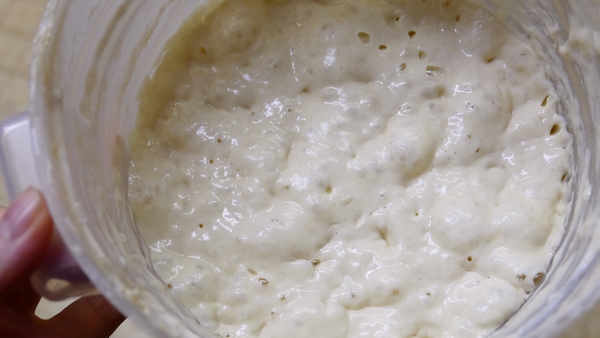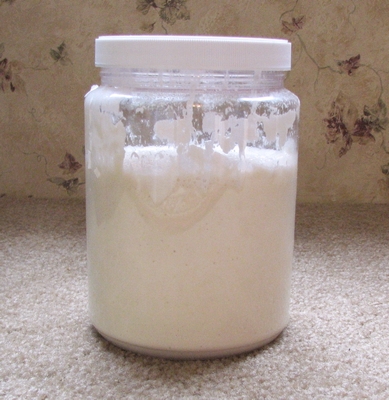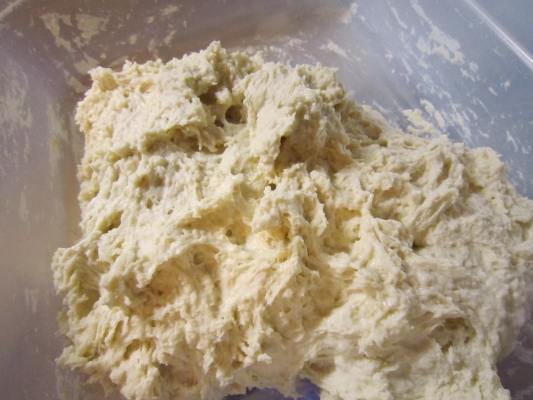Feeding Your Sourdough Starter


Hello fellow bakers!
A student asked me what ratio to feed a sourdough starter at and so I felt it was a good time to answer this question for everyone’s benefit.
Feeding a sourdough starter is an intuitive thing for a baker. You would feed your starter maybe 1:3:3 (one part starter to three parts water and three parts flour) or even 1:4:4 (or even more food) if you wish to have it vigorous the next day after an overnight room temperature ferment or if you wanted to leave it in the fridge for a long time. In that case you are starting with a low inoculation (low amount of starter) and there is plenty of food available to keep the microorganisms happy. It depends upon how warm the temperature is as well.
If you feed your starter in the morning to have ready by the afternoon you would leave a higher ratio of starter to food so that it is actually ready when you need it (which depends mainly on temperature and timing). So maybe you would use 1:1:1
Some doughs are special and they use two or more pre-ferments, some even use a spent starter for a looser, more slack dough. So the feeding for those pre-ferments would be pre-determined and spelled out in the formula.
A lower hydration starter will use up it’s food slower than a more liquid starter. So a liquid starter might need to be fed more and more often depending upon usage, temperature and flour type. A lower hydration starter is easier to transport because it ferments more slowly.
So it depends on what you plan to do with it and when. The longer and the warmer the more food you need. The cooler and the shorter time, the less food you need. In warmer climates, it’s usually a good idea to feed a higher ratio of food and a very low ratio of starter. Different types of flour will also ferment more quickly so you have to keep that in mind when you feed (whole grains ferment more quickly).

If you are going to leave your starter unfed for a long time in the fridge, leave just a small amount on the bottom of the container and feed it a lot. It will last a long time in cold conditions with lots of food.
Of course you always need to feed your starter enough food to make sure there is plenty for the formula and some left over to maintain your starter. If your formula calls for 200 grams of starter and you are feeding it the night before mixing in the morning. You might want to start out with 50 grams of starter, 100 grams of flour and 100 grams of water. If it’s very warm where you are, you may want to use 10 or 20 grams of starter and feed 100 grams of water and 100 grams of flour. You should experiment to see what works for you with your flour, starter, time and temperature.
Like I said, it’s intuitive, you understand intuitively how much to feed your starter the longer and more often you bake.
For troubleshooting sourdough problems see HERE.
Comment below to give us your schedule or method of feeding your starter (we need to know!).
Also let me know if I left anything thing out and add it below.
Happy Baking!
Teresa


I just discovered this fantastic blog.
I live in Portland, OR and was an early partner in Marsee Baking, shortly after we moved here in the mid ’90’s.
I now only bake for friends and family in small batches and have learned a lot just reading the blog posts.
Keep up the great work.
My family were European trained bakers, when my dad moved to the States in the late 40’s he brought his rye starter that he brought from Germany and then London. During the war he kept it alive by feeding it a few grams of flour every day and an equal amount of water and starter. Due to rationing, he did not bake with the sour for over 10 years, he just kept the same sour alive and threw out half the sour 2 times a week, as his jar filled to the brim. As far as
i know, the sour finally died out when the bakery closed in the mid 80’s. The same base was used to start both our dark and light rye when he opened his bakery in the States. My dad often shared his starters with many of bakeries in Syracuse after the blizzard of ’66 when he and I traveled around dropping off a gallon to bakeries that could not open for over a week or more. I don’t know if the strain is still around, but it was a very hearty strain that never disappointed.
I am feeding my very first sourdough starter. However, I have just realised now after 2 days that I had made an error on the amount to feed on the 2nd day.. I started with 50gr flour and 50gr water. On the 2nd day, i made an error by only feeding 30gr flour and 30gr water. On the 3rd day, today, I decided to go ahead with 80gr of flour with 80gr water. Hopefully it will compensate the error I have made earlier. Will this affect the result of the starter?
Hello Elana, sourdough starters are pretty resilient. You will do fine, just continue to discard some and feed twice a day every day for two weeks. You can always check on this page with a video series about making a starter too: https://thebakingnetwork.com/begin-here/beginners-guide-sourdough/
Buon giorno Teresa, ringrazio molto per avermi accettata nel vostro bel gruppo. Mi chiamo Mariangela ho 67 anni e sono italiana. Mi sono avvicinata alla panificazione con lievito naturale ( madre ) da un paio di anni e vorrei migliorare il mio saper fare il pane. Tuttavia mi preoccupa un pò la lingua, io conosco solo l’italiano e la traduzione automatica a volte non è molto chiara. Vorrei per il momento provare il blog gratuito. Mille grazie. Mariangela
Benvenuto! Bello averti con noi Mariangela. Io uso Google Traduttore. Sembra funzionare abbastanza bene.
I don’t bake as often as you do, so I refresh 1:1:1. It keeps the same hydration, and there is no math involved.
I’m going to be sharing this blog post a lot. All my friends ask for starter on a regular basis because they kill it within a few months.
Thank you Rochelle 🙂